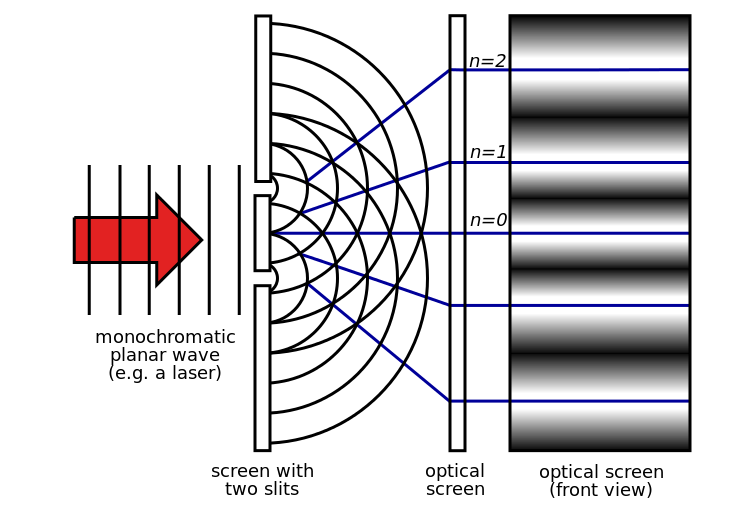How to Use Light to Cool and Trap Atoms, Part 1: The Nature of Light
2019-02-11
This is Part 1 in what will be a series of blog posts about how light can be used to accelerate and trap atoms. Much of the research that goes on in modern atomic physics owes itself to developments in this area, such as the achievement of Bose-Einstein Condensates (BECs) in 1995, a new state of matter that demonstrates interesting quantum properties on a macroscopic scale [1]. Even more recently, half of the 2018 Nobel Prize in Physics went to Arthur Ashkin for the development of optical tweezers, which fundamentally rely on the idea that light can be used to accelerate small charged particles. But before describing how exactly light can be used in these interesting ways, we should first spend a little bit of time talking about what light actually is.
Light is interesting because it is hard to pin down its properties. In experiments like the double-slit experiment (diagram below) it acts like a wave, exhibiting properties like interference, reflection, and diffraction.
 Figure 1: A diagram of the double-slit experiment, which demonstrates that light acts like a wave rather than a classical particle. If light was a classical particle with definite position and momentum, we would expect to see a pattern on the optical screen that is brightest at the point directly across from the slit and becomes less bright as the angle from the slit to the point on the screen gets larger. Instead, we find that the light passing through the top slit will interfere with the light that passes through the bottom slit, producing an alternating pattern of light and dark bands on the optical screen where the light constructively and destructively interfered with itself, respectively. Image obtained from Wikimedia Commons.
Figure 1: A diagram of the double-slit experiment, which demonstrates that light acts like a wave rather than a classical particle. If light was a classical particle with definite position and momentum, we would expect to see a pattern on the optical screen that is brightest at the point directly across from the slit and becomes less bright as the angle from the slit to the point on the screen gets larger. Instead, we find that the light passing through the top slit will interfere with the light that passes through the bottom slit, producing an alternating pattern of light and dark bands on the optical screen where the light constructively and destructively interfered with itself, respectively. Image obtained from Wikimedia Commons.
However, in other instances, like the photoelectric effect, light will act more like it consists of particles! This particle, called a photon, is a discrete packet of energy that travels at the speed of light. In a 2015 experiment performed at École polytechnique fédérale de Lausanne (EPFL) in Switzerland, physicists even managed to simultaneously observe light acting as both a particle and a wave [2]!
So what exactly is light, then? This can easily become a philosophical discussion about what it actually means to be something, but I will simply choose to define light by the properties it exhibits. Under this definition, I would say that what light is depends on the specific context in which we are considering it. In most “everyday” situations, where there are enormous numbers of photons contained in beams of light, the relevant physics and observed properties all correspond with the interpretation of light as a wave. However, on more microscopic length and energy scales, the interpretation of light as a particle is often much more consistent with observations. And as described above, we can even create situations in which light acts like both at once!
Now that we have a better idea of what light is, we are ready for the next blog post, where we will be exploring how light can be used to cool down a sample of atoms! Feel free to comment any feedback you have about this post, or suggestions for future topics for this blog!
References
[1] Anderson, Mike H., et al. “Observation of Bose-Einstein condensation in a dilute atomic vapor.” science 269.5221 (1995): 198-201.
[2] Piazza, L. U. C. A., et al. “Simultaneous observation of the quantization and the interference pattern of a plasmonic near-field.” Nature communications 6 (2015): ncomms7407.